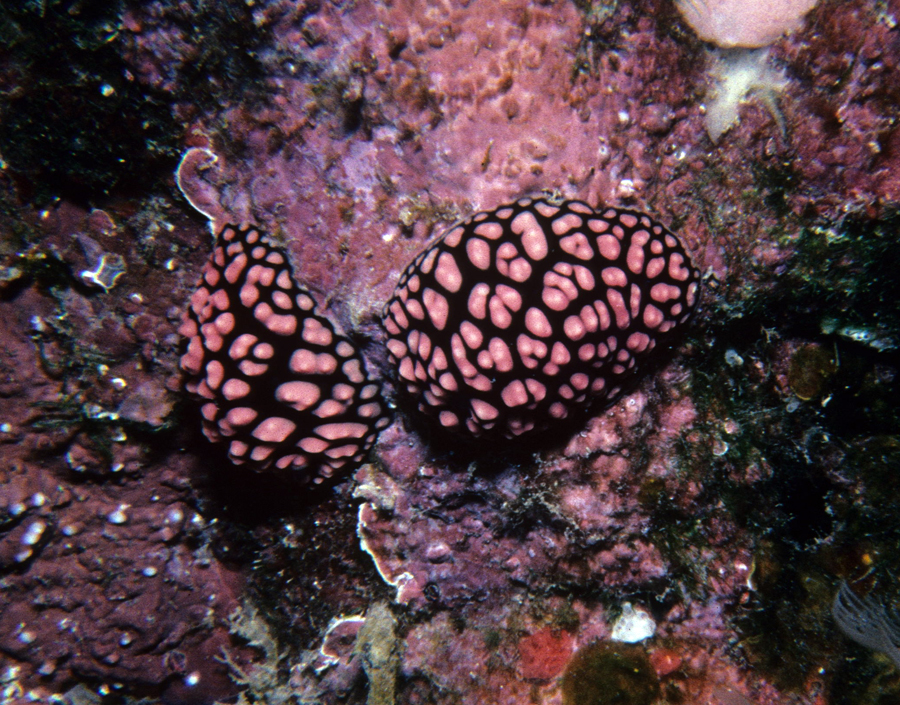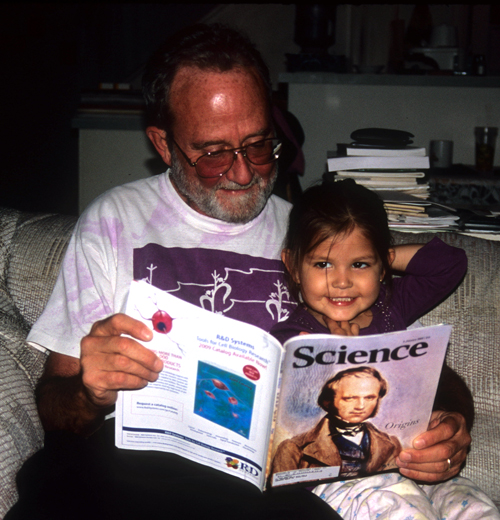 |
Phyllidiella pustulosa
Pair of animals in situ, Makua, O'ahu
40 feet deep, August, 1981
Photo by Hans Bertsch
Phyllidiella pustulosa (Cuvier, 1804)
This warty-stinky slug is “one of the most common nudibranchs throughout the Tropical Indo-West Pacific,” occurring at many localities (Brunckhorst, 1993). Scott Johnson, at www.underwaterkwaj.com/nudi/porostomes/e044.htm , notes it is the “most often observed nudibranch in the Marshall Islands, both because it is common and because it tends to sit out in the open on hard substrates during the day,” from 4 to 60 m in depth. Animals range in size from 8-69 mm, averaging about 30 mm in length.
It is “recognizable by its predominantly black body with pink tubercles arranged in small clusters” (Gosliner, Behrens & Valdés, 2008).
Diagnostic features include 3 median clusters of pink tubercles ; pale pink edge to the mantle; broad, triangular, black-tipped oral tentacles; and rhinophoral clavus possessing 22-26 lamellae in specimens > 35 mm (Brunckhorst, 1993).
This animal changes in appearance as it grows, a factor that has led to its over-naming and synonyms. Brunckhorst wrote, “The majority of phyllidiid species that I have studied show little ontogenetic variation in dorsal pattern (i.e., juveniles resemble adults). Phyllidiella pustulosa is an exception and the considerable ontogenetic variation in its dorsal pattern has led to confusion.” Since the porostome Phyllidiidae lack a radula, they obviously cannot exhibit the ontogenetic radular variation reported for spongivorous cryptobranchs (Bertsch, 1976).
There are numerous reports and photographs of Phyllidiella pustulosa on various internet sites. Bill Rudman's Sea Slug Forum, www.seaslugforum.net , has over 100 postings! Leanne and David Atkinson (18 August 2007) contributed a picture of an animal with its “milky defensive secretions” (photographed on Vanuatu), and Mirjam Broos (18 May 2007) contributed Geert Prost's photo of a copulating pair from Lembeh Strait, North Sulawesi, Indonesia.
Cory Pittman and Pauline Fiene, www.seaslugsofhawaii.com/species/Phyllidiella-pustulosa-a.html , illustrate variation in Hawaiian animals. Bob Bolland, at www.rfbolland.com/okislugs/phylpus2.html , illustrates an Okinawan Phyllidiella pustulosa with its mimic the polyclad flatworm Pseudoceros imitatus Newman, Cannon & Brunckhorst, 1994. However, write Newman & Cannon (2003: 41-42), “these flatworms are so rare that we still don't know if this worm is itself toxic or if it only mimics the toxic species” (Müllerian vs. Batesian mimicry).
Phyllidiella pustulosa is the type species of the genus Phyllidiella Bergh, 1869. Brunckhorst (1993) describes and distinguishes the genera of Phyllidiidae.
Literature Cited
Bertsch, Hans. 1976. Intraspecific and ontogenetic radular variation in opisthobranch systematics (Mollusca: Gastropoda). Systematic Zoology 25 (2): 117-122.
Brunckhorst, David J. 1993. The systematics and phylogeny of phyllidiid nudibranchs (Doridoidea). Records of the Australian Museum, Supplement 16: 1-107.
Gosliner, Terrence M., David W. Behrens & Ángel Valdés. 2008. Indo-Pacific Nudibranchs and Sea Slugs. A field guide to the World's most diverse fauna. Sea Challengers Natural History Books, Etc., Gig Harbor, WA, and California Academy of Sciences, San Francisco. 426 pp.
Newman, Leslie & Lester Cannon. 2003. Marine Flatworms: The World of Polyclads. CSIRO Publishing, Collingwood, VIC, Australia. viii + 97 pp.
Hans Bertsch
Universidad Autónoma de Baja California Sur, La Paz, BCS, México,
and Imperial Beach, CA

|
